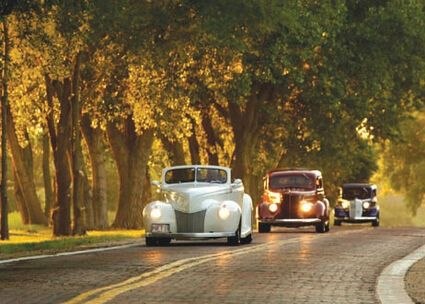Lincoln Highway receives National Scenic Byway designation
June 24, 2021
KLOEE SANDER
Nebraska Press Association
Every traveler has time to stop for ice cream.
And when travelers make it to Potter, Nebraska, the ice cream shop adorned in red and white draws them in. The Potter Sundry old-fashioned soda fountain is home to a classic—the tin roof sundae, which is made of chocolate and vanilla ice cream, chocolate syrup, fluffy marshmallow cream and nuts.
As weary wanderers walk into the Sundry, they are stepping back in time. The antique tin ceiling captivates them as they eat the sweet treat that was created there. Travelers chat with locals and learn about this Western Nebraska village and feel at home.
Potter, population about 300, is something truly special, Nebraska tourism officials agree. Its soda fountain is one of the top spots along the newly designated Lincoln Highway Scenic and Historic Byway.
The coast-to-coast Lincoln Highway stretches from Times Square to San Francisco. Nebraska’s portion stretches 450 miles through the towns such as Omaha, Kearney, Ogallala and Kimball. It was named “Lincoln” as a tribute to Abraham Lincoln but is also known as U.S. Highway 30. The Lincoln Highway was one of the first two Nebraskan highways to receive the National Scenic Byway Designation by the Federal Highway Administration in February. The other byway designated was the Nebraska Sandhills Journey Scenic Byway or U.S. Highway 2 from Grand Island to Alliance.
The National Scenic Byway program began in 1991 and recognizes highways that have at least two of the six intrinsic qualities: scenic, natural, historic, cultural, archaeological and recreational. The program was dormant for seven years until the bipartisan Reviving American’s Scenic Byway Act reinstated the program in January 2019, said Mark Falzone, the CEO of the National Scenic Byway Foundation.
Nebraska has coveted the designation for years, said Muriel Clark, president of the Nebraska Lincoln Highway and Scenic and Historic Byway. So, when the Federal Highway Administration announced, in December 2020, the designation applications would open in February and close in June, her team got to work. A major component of the application was a corridor management plan and normally takes years to complete. However, her team created one in a matter of months. COVID-19 did them a favor—they were able to work from home with the distraction of office duties, she said.
Even without the extra distractions, completing the corridor management plan in such a short time was difficult to do, said Sarah Focke, the Nebraska director on the National Lincoln Highway Association Board. The team found 67 historical markers on the byway and researched their stories to make the Lincoln Highway’s application stand out.
The National Scenic Byway Foundation stepped in to help Lincoln Highway officials complete the applications and structure the plan. Sharon Strouse, executive director for the foundation, worked with Nebraska closely through mentoring, trainings and numerous phone calls. Strouse said the Lincoln Highway was a great candidate for the byway designation because it tells a unique story of Nebraskan economics, travel and history through the landmarks along it. Strouse was able to help Nebraska tourism officials showcase the history and character of the byway in the management plan.
Officials working on the application researched the highway’s role in Nebraska history, economics, recreation and culture. The highway runs along the historical Oregon, Mormon and California trails and the Pony Express route. There is an abundance of wildlife, including Sandhill cranes during their migration, that can be seen along the highway. Small-town wonders like historic gas stations and diners were marked as important stops on the highway. Once locations were recognized, officials said physical improvements were made along the highway to enhance the storytelling locations. These physical improvements included updating signage, removing billboards that obstruct scenic views, cleaning up along the roads and outlooks and ensuring small towns have the resources to welcome new visitors, officials said.
As Nebraskans begin to plan summer vacations, the Lincoln Highway provides a scenic and historical route for travelers to take. It provides an alternate route to see history while traveling and will increase tourism, Focke said. Minnesota’s 2010 scenic byway designation brought in an extra 23,800 groups in the region and created $21.2 million in sales and 331 jobs.
Officials hope the national designation will bring similar prosperity to communities in Nebraska through economic benefits and increased community pride, Clark said.
“I think we can look around as residents with a little bit more of awareness that ‘Oh, these places are special,’ and you know, ‘Let’s go see them ourselves. Let’s clean up the roadways and spruce up our little towns and do what we can to identify ourselves with these roadways,’” she said.
The citizens of Potter did just that. Their community came together to enhance and celebrate Nebraska history through something as simple as an ice cream shop. The village of Potter showcases the forgotten stories of the Nebraska Highway and reminds people that they are driving on history.





Reader Comments(0)